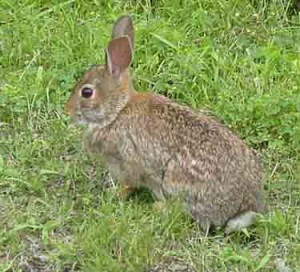
General: The eastern cottontail rabbit, as with all rabbits, are prolific animals. A female may give birth and within hours after giving birth, be bred again. Three weeks later she will have another litter. The young of the first litter fend for themselves when the second litter arrives.
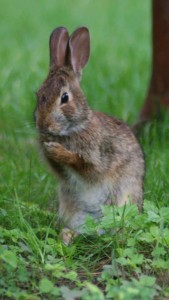
Eastern cottontail rabbit feces is typically round and approximately 1/4″ in diameter. There is typically a small grouping of pellets together. The picture below is of eastern cottontail feces.
Almost all predators including rattlesnakes, hawks, mink, foxes, bobcats, fishers, weasels, coyotes, dogs, cats, skunks, raccoons, and wolves eat cottontails.
The cottontail breeding season typically begins in late February and lasts through September. Gestation lasts 27-32 days. The female will breed and multiple litters will be born each year – a female will have anywhere from 1 – 6 litters each season!!
When pregnant, the female (doe) will dig a nest cavity. The nest measures 5” – 7” wide and approximately 7” deep (see picture). She will line the nest with grass and leaves and then with her fur. Typically, after the nest is complete, the opening is covered up.
At birth, kits are hairless, sightless, and virtually helpless. There are typically 3-6 young in each litter. They weigh about an ounce. Kits leave the nest after three weeks.
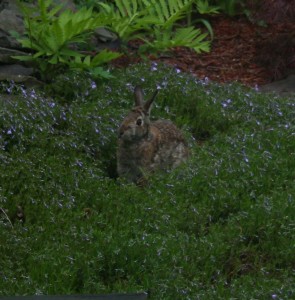
The pictures of the cottontail in the flowers shows how the nest is built, what the excavation looks like and finally when complete, how the doe camouflages the opening. It only took the rabbit approximately 10 minutes from start to finish. Several weeks later my wife watched the doe breast feeding the kits. Two weeks later the nest was abandoned. Reproductive maturity occurs at about 2 to 3 months of age.
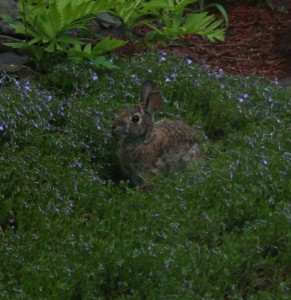
A disease that is deadly to rabbits is tularemia. Tularemia is caused by a bacterium, Pasteurella tularensis, which is transmitted to the rabbit by ticks or fleas. A number of wildlife species and humans can contract the disease, but it usually occurs in rabbits and rodents. The disease is always fatal to the rabbit, with most succumbing to the illness within 10 days following onset. As mentioned, humans can contract the disease. However, it responds quickly to antibiotics and is not considered a serious health threat if treated promptly. The following precautions will greatly reduce your risk of exposure:
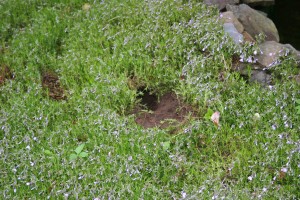
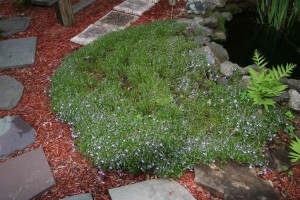
•Do not harvest rabbits that appear sluggish or do not run.
•Wear rubber gloves when dressing rabbits.
•After removing the gloves, wash your hands with antibacterial soap.
•Cook rabbit meat thoroughly. Do not eat rare or undercooked rabbit meat.
Identification: The eastern cottontail is chunky red-brown or gray-brown in appearance with large hind feet, long ears and a short fluffy white tail. Its underside fur is white. There is a rusty patch on the tail. Its appearance differs from that of a hare in that it has a brownish-gray coloring around the head and neck. The body is lighter color with a white underside on the tail.
The average adult weighs about 2 – 4 lbs with the female tending to be heavier. They are between 12” – 16”.
Habitat: Optimal eastern cottontail habitat includes open grassy areas, clearings, and old fields supporting abundant green grasses and herbs, with shrubs in the area or edges for cover.
Eastern cottontails can be found on farms, fields, pastures, open woods, thickets, fencerows, forest edges, and suburban areas. They are also found in swamps and marshes and usually avoid dense woods. Trick here is to look for food and cover.
They are seldom found in deep woods.
Territory: The eastern cottontail has a wide distribution and is found throughout most of the eastern United States. They range from eastern and south-central United States, southern Canada, eastern Mexico, Central America and northernmost South America. Originally, it was not found in New England, but it has been introduced there and now competes for habitat there with the native New England Cottontail.
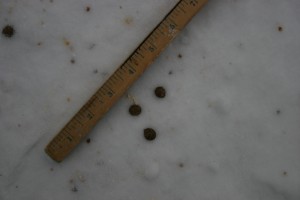
Diet: Cottontails eat green plants, twigs, tree bark, fruits, buds, flowers and seeds. I have watched eastern cottontail rabbits eat fallen bird seed during winter. Eastern cottontails produce two types of fecal pellets one of which is consumed. The digestion of fecal pellets increases the nutritional value of dietary items. They are a pain in the ass in the garden. They have eaten my bean plants, carrot tops, beet greens, cabbages, etc. During winter they have gone after my blue berry plants.
